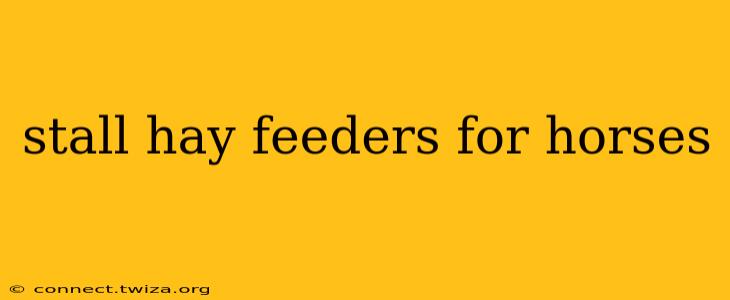Choosing the right hay feeder for your horse can significantly impact their health, comfort, and overall well-being. Stall hay feeders are designed to slow down eating, prevent waste, and minimize the risk of choking or colic. This guide will explore the various types of stall hay feeders available, helping you make an informed decision for your equine companion.
What are the benefits of using a slow feed hay net for horses?
Slow feed hay nets and feeders offer numerous advantages. Primarily, they encourage slower eating, which is crucial for preventing digestive issues like colic and ulcers. This slower consumption rate also promotes better digestion and nutrient absorption. Furthermore, they reduce hay waste, saving you money in the long run. The controlled feeding also helps horses maintain a healthy weight, particularly important for those prone to obesity. Finally, many slow feeders offer a more engaging and stimulating feeding experience for horses, preventing boredom.
What are the different types of stall hay feeders available?
The market offers a diverse range of stall hay feeders, each with its own advantages and disadvantages. Here are some popular types:
1. Slow Feed Nets:
These are perhaps the most common type, available in various mesh sizes and designs. They can be hung from the ceiling or a sturdy wall mount, making them easy to adjust to different horse heights. The mesh size influences how quickly the horse can eat, with smaller mesh sizes providing a slower feeding rate.
2. Hay Bags:
Similar to slow feed nets, hay bags are often made from durable fabric with smaller openings. They are generally more robust than nets and can withstand more aggressive feeding habits.
3. Hay Feeders with Slow Feed Mechanisms:
These feeders often incorporate a unique design that restricts access to hay, forcing the horse to work for their meal. Some designs incorporate a series of small compartments or a maze-like structure.
4. Floor Feeders:
Floor feeders are designed to sit on the ground of the stall. While not strictly "slow feed," they can help reduce waste by preventing the horse from stepping on or scattering the hay. They are particularly beneficial for horses who are less likely to be able to reach a hung feeder.
5. Combination Feeders:
These innovative feeders combine the features of multiple types, like a slow feeder net contained within a sturdy frame for additional support.
How do I choose the right stall hay feeder for my horse?
Selecting the appropriate hay feeder depends on several factors:
- Your horse's size and eating habits: A larger horse will require a larger capacity feeder, while a horse prone to bolting their food might benefit from a very slow feeder.
- The type of hay you are feeding: Long-stemmed hay will often require a feeder with larger openings, whereas more processed hay can be used with smaller mesh.
- Your budget: Prices vary widely depending on the material, size, and features of the feeder.
- Space limitations: Measure your stall to ensure the feeder fits comfortably without obstructing movement.
What are the potential downsides of using a stall hay feeder?
While generally beneficial, slow feeders have some potential drawbacks. Some horses may find them frustrating, leading to increased stress or boredom. Also, ensure you check the feeder regularly to make sure it’s clean and that there are no potential hazards, such as sharp edges or frayed materials. Finally, improper use, like overfilling, could still lead to wastage or choking hazards.
How do I clean my horse's stall hay feeder?
Regular cleaning is essential to prevent mold and bacterial growth. Remove any leftover hay daily, and wash the feeder with soap and water at least once a week. Allow it to dry completely before refilling.
Are slow feed hay nets safe for horses?
Slow feed hay nets are generally safe when used correctly. However, always supervise your horse initially to ensure they are using the feeder safely and not becoming stressed. Select nets with a secure hanging system and a mesh size appropriate for the type of hay you are feeding to reduce the risk of choking.
By carefully considering your horse's individual needs and the available options, you can choose a stall hay feeder that promotes their health, happiness, and well-being. Remember to prioritize safety and regularly inspect your chosen feeder.
